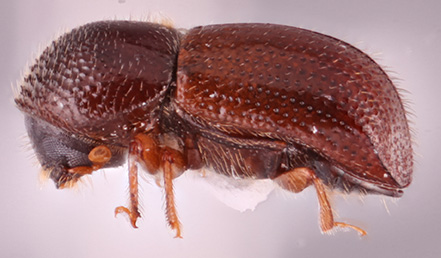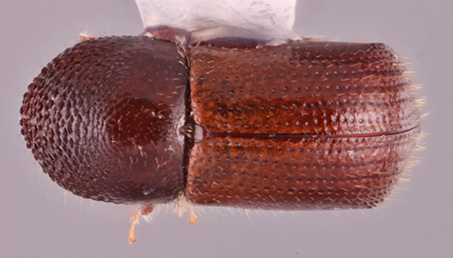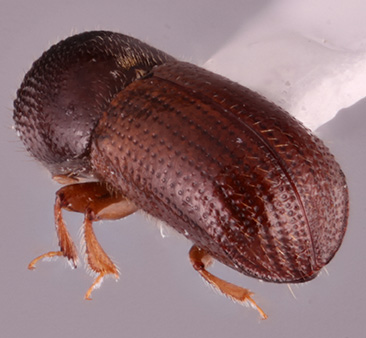Xylosandrus dentipennis
|
Xylosandrus dentipennis paratype lateral; R.K. Osborn |
|
Xylosandrus dentipennis paratype dorsal; R.K. Osborn |
|
Xylosandrus dentipennis paratype declivity; R.K. Osborn |
|
Xylosandrus dentipennis paratype frontal; R.K. Osborn |
Taxonomic history
Xylosandrus dentipennis Park & Smith, 2020 (in Park et al. 2020Park et al. 2020:
Park S, Smith SM, Cognato AI, Beaver RA. 2020. Catalogue of Korean Xyleborine ambrosia beetles (Coleoptera: Curculionidae) with seven new species. Journal of Asia-Pacific Biodiversity 13: 210-228. https://doi.org/10.1016/j.japb.2020.01.002): 224.
Diagnosis
2.15−2.36 mm long (mean = 2.3 mm); 2.40−2.56 times (Park et al. 2020Park et al. 2020:
Park S, Smith SM, Cognato AI, Beaver RA. 2020. Catalogue of Korean Xyleborine ambrosia beetles (Coleoptera: Curculionidae) with seven new species. Journal of Asia-Pacific Biodiversity 13: 210-228. https://doi.org/10.1016/j.japb.2020.01.002). This species can be distinguished by its moderate size; elytralelytral:
'pertaining to the elytra
discdisc:
the flat central upper surface of any body part (e.g. pronotum and elytra) gradually curving toward declivitydeclivity:
gradually curving toward declivitydeclivity:
downward slope of either the pronotum or elytra
 , appearing rounded; posterolateralposterolateral:
, appearing rounded; posterolateralposterolateral:
'relating to end of the side part/portion
 margins of elytraelytron:
margins of elytraelytron:
'
the two sclerotized forewings of beetles that protect and cover the flight wings
carinate to interstriaeinterstria:
'longitudinal spaces along the elytra between the striae, which is not as<br />
impressed and bear smaller punctures.
 7; declivitaldeclivital:
7; declivitaldeclivital:
pertaining to the elytral declivity
face with six punctatepunctate:
'set with fine impressed points, appearing as pin pricks
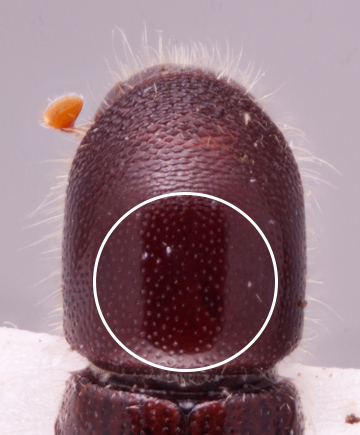 striae; declivitaldeclivital:
striae; declivitaldeclivital:
pertaining to the elytral declivity
interstriae denticulate-granulate, uniseriate with minute erecterect:
'pertaining to setae that have their apices directed away from the body and appear straight
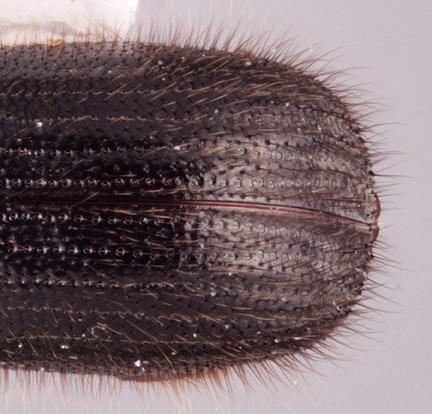 setae less than the width of an interstriainterstria:
setae less than the width of an interstriainterstria:
'longitudinal spaces along the elytra between the striae, which is not as<br />
impressed and bear smaller punctures.
 ; pronotumpronotum:
; pronotumpronotum:
'the dorsal surface of the thorax
as long as wide; pronotumpronotum:
'the dorsal surface of the thorax
from dorsaldorsal:
'of or relating to the upper surface; opposite of ventral
 view rounded (type 1) and laterallateral:
view rounded (type 1) and laterallateral:
'pertaining to the side
 view basic (type 0), summitsummit:
view basic (type 0), summitsummit:
highest point, used for pronotum and elytra, denotes the peak between pronotal frontal slope and disc, and between elytral disc and declivity at midpoint, basalbase:
at midpoint, basalbase:
point or edge closest to the body; opposite of apex half smooth, shiningshining:
half smooth, shiningshining:
appearing glossy or bright in luster; referring to a surface that is polished and reflects light well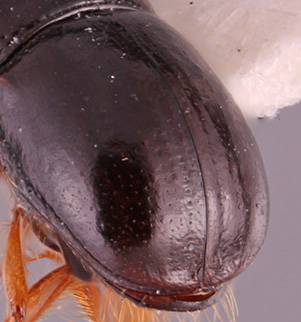 , sparsely minutely punctatepunctate:
, sparsely minutely punctatepunctate:
'set with fine impressed points, appearing as pin pricks
 ; and sparse mycangial tuftmycangial tuft:
; and sparse mycangial tuftmycangial tuft:
'tuft of setae that denotes the mycangia exterior opening
 on the pronotalpronotal:
on the pronotalpronotal:
'pertaining to the pronotum
basebase:
point or edge closest to the body; opposite of apex .
.
May be confused with
Anisandrus dispar, A. maiche, A. paragogus, Xylosandrus eupatorii, X. germanus, and X. metagermanus
Distribution
China (Fujian, Guizhou, Jiangxi, Shanghai, Yunnan), Japan, South Korea
Host plants
This species has only been recorded from Camptotheca (Nyssaceae) and Magnolia (Magnoliaceae) (Park et al. 2020Park et al. 2020:
Park S, Smith SM, Cognato AI, Beaver RA. 2020. Catalogue of Korean Xyleborine ambrosia beetles (Coleoptera: Curculionidae) with seven new species. Journal of Asia-Pacific Biodiversity 13: 210-228. https://doi.org/10.1016/j.japb.2020.01.002).
DNA data
Sequences available for COI and CAD.

